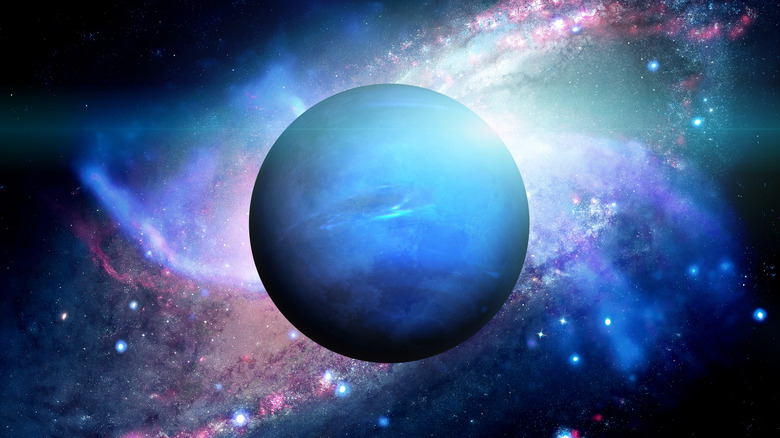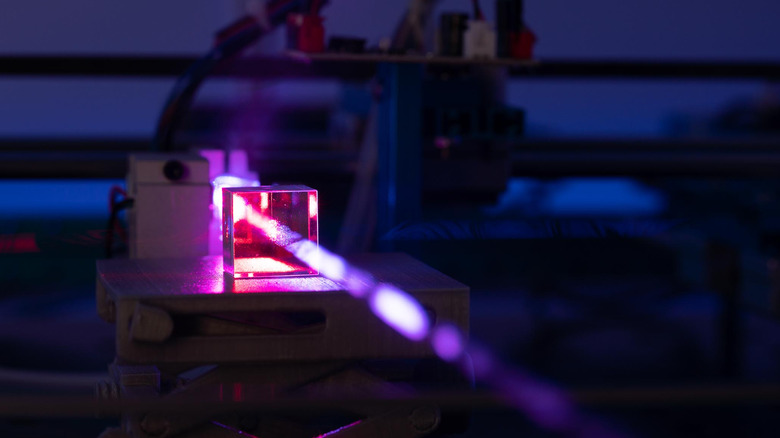The Strange Interstellar Phenomenon Of Superionic Ice
Ice: That melting stuff on the poles that slaves used to cart down from the Swiss Alps in massive blocks for the playtime fun of the wealthy of ancient Greece and Rome, now dispensed pre-crushed from the doors of common household refrigeration units. Ice: The frozen form of water molecules — made of two atoms of hydrogen bonded to one atom of oxygen — when it loses enough energy to transition from liquid to solid at 0 degrees Celsius. Since 1867, when Texas businessman Andrew Mulh created the first commercial ice-production machine, we've all developed a pretty dependent relationship on what is now an everyday item, per Alcohol Professor.
Ice isn't only on our beloved home, Earth, but scattered across our solar system. It's on the poles of the Moon (per NASA) and stored in pocketed "micro cold traps" across its surface that could amount to "trillions of pounds of water" (per Smithsonian Magazine); it forms the multilayered ice-water-ice shell of Saturn's moon Titan; it's within the icy crust of Jupiter's moon Europa; in the rock-and-ice cores of the gas giants Uranus and Neptune; it's even just affixed to random asteroids careening around the stellar neighborhood (per Space).
But could it be that we've got ice all wrong? Recent scientific discoveries illustrate that across the universe, what we know as "ice" may be rare, while a blackened, far hotter form of it — superionic ice — might be much more common.
A black, hot, part-solid, part-liquid crystalline lattice
So how can ice be hot or black when it's clearly cold, frosted, and translucent white? After all, space is minus 270 degrees Celsius (minus 455 degrees Fahrenheit) on average (per Astronomy), so it seems sensible to imagine that the ice in space resembles ice on Earth. However, as outlets such as Quanta Magazine explain, it all depends on how the ice is formed. On Earth, we get "normal ice" when we take water and make it cold enough to freeze — simple. But in the rest of the universe, ice might form from different means entirely. According to a Nature study published in 2019, the result would resemble a different substance altogether: a part solid, part liquid crystalline lattice.
The story of this newly discovered form of ice — which solves numerous questions physicists had about the cores and structures of planets like Uranus and Neptune — started back in 1988. At the time, chemist Pierfranco Demontis of the University of Pennsylvania published a paper titled "New High-Pressure Phases of Ice" (archived on the American Physical Society). During this experiment, he ran an ionic computer model demonstrating how water would take on new properties if subjected to pressure and heat at levels beyond those commonly found on Earth. According to the model, it would retain characteristics of solids and liquids while existing as a new state of matter that was neither. Sure enough, 30 years later, researchers found out he was right.
Uranus and Neptune provided a crucial clue for computer models
Uranus and Neptune provided the first clues about what is now called "superionic ice," per Quanta Magazine. Launched in 1977, the Voyager 2 probe eventually discovered that the planets' magnetic fields appeared "lumpier and more complex" than planets like Jupiter, which had clear north and south poles. Scientists attributable this clarity to "dynamos" of superconductive fluids in its center, which work together to act as a giant magnetic rod running along the planet's axis. At the time, it was believed that Uranus and Neptune's apparent multiple poles would only be possible if their outer layers transitioned to solid, icy cores. In short, it seemed impossible.
The original 1988 simulation illustrated that water morphs under extreme pressure and heat in a very particular way. Its hydrogen atoms split from oxygen and start zinging around, effectively reduced to protons (positively charged particles) as oxygen lines up along a crystal-like lattice as hard as metal. The protons conduct electricity just like metal, too, while their disorder makes the melting point of the substance rise so high that it could be subjected to extreme heat before further changing state. In other words, it becomes black and hot ice, where "ice" is defined as the solid form of the water molecule — not necessarily the stuff that chills your drinks.
Further tests incorporated not just classical but also quantum physics. And lo and behold, Nature magazine brought us the 2019 paper, "Nanosecond X-ray diffraction of shock-compressed superionic water ice."
Lasers shot into crystal created Ice XVIII
The actual experiment is outlined in many places: Quanta Magazine, the University of Rochester, Physics Today, the U.S. Department of Energy's Lawrence Livermore National Laboratory — the list goes on. It starts out with everyday common ice, designated by scientists as ice Ih, in which molecules are aligned hexagonally. After this, we've got 18 other architectures of ice, starting with Ic and going all the way to Ice XVII. The new, superionic ice? Ice XVIII.
Researchers Marius Millot and Federica Coppari of Lawrence Livermore National Laboratory in California started with room-temperature water squeezed into cut diamonds. From here, they raised the pressure to a gigapascal, which is about 10 times the pressure at the bottom of the Marianas Trench. Under this extreme pressure, the water transformed into the tetragonal ice VI — a four-sided figure. But they didn't stop there: at 2 gigapascals, the molecules shifted into ice VII, a transparent cube that naturally exists inside diamonds. The pair then shot the ice VII with a laser that was 4,700 degrees Celsius, which transformed it into the electricity-conducting, proton-laced, semi-solid, semi-liquid Ice XVIII — just like the old 1988 computer simulation predicted. Theory became reality.
Over time, as in the cores of planets like Uranus and Neptune, superionic ice would shift in a goopy way and change shape. This is exactly what would create not only the magnetic fields discovered by Apollo 2, but the aforementioned icy giants spinning deep in the cosmos. And this kind of ice — not the kind on the Moon or Earth — could be the most common type in the universe.



